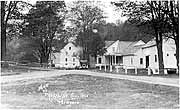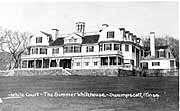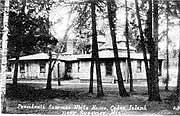Calvin Coolidge and Summer White Houses
by Ellyn R. Kern
Ellyn R. Kern is editor of The Presidents’ Journal quarterly [Cottontail Publications, 79 Drakes Ridge, Bennington, IN 47011], in which this article originally appeared, Volume XVII #4, Winter 2001.
Calvin Coolidge was a man of frugal habits that carried over from his personal to political philosophy. He owned only one home in his life which was “The Beeches” and it was purchased after his presidency in order to achieve privacy not available in their former Northampton home. He had continued the presidential family practice of leaving Washington in the summer and establishing a “Summer White House” wherever he stayed.
 Until his father’s death he usually would return to his boyhood home during the summer months.
Until his father’s death he usually would return to his boyhood home during the summer months.
In 1924, the upper floor of the store his father operated at the time of Calvin’s birth, served as his summer office.
In 1925, at the suggestion of Mrs. Coolidge, they stayed at White Court in Swampscott, Massachusetts to be near the senior Coolidge who was ailing. She regretted her choice as Coolidge found nothing in the leisure choices for his tastes, even though she was pleased with the gardens and swimming opportunities. Their son, John, was in his second summer of military training at Camp Devens.
The summer executive offices were three miles away in Lynn. Entertaining took place at White Court or on the presidential yacht, the Mayflower, which was anchored nearby. They attended church at the Congregational Tabernacle at Salem.
 White Court was a long rambling white house with its lawn stretching to the rocky coast. There were swimming pools and ocean bathing as well as lovely gardens.
White Court was a long rambling white house with its lawn stretching to the rocky coast. There were swimming pools and ocean bathing as well as lovely gardens.
In 1926, the experience at White Pines Camp, close to Saranac Lake in the Adirondacks, was much more enjoyable because this is where Coolidge developed his love for fishing. Colonel Starling and other staff members joined him in the sport. Coolidge spent his morning in executive offices at Paul Smith’s. The camp was a group of detached houses built of split logs and overlooking Lake Osgood. When they moved indoors to avoid the mosquitoes they enjoyed the living room with Oriental rugs and marble fireplace. Grace again enjoyed the lovely gardens and her daily walks. They frequently entertained here. Church attendance was at the Presbyterian Church in Saranac Lake.
The summer of 1927 in the Black Hills of South Dakota was most notable for Coolidge’s famous statement, “I do not choose to run for President in nineteen twenty eight,” which was announced from his offices in the high school at Rapid City. He was in the Black Hills for the dedication of Mt. Rushmore, but stayed for three months. Their white collie, Prudence Prim, died while they were in the Black Hills, a sad happening of the stay.
Another unfortunate incident that made headlines occurred when Mrs. Coolidge was late returning from her daily walk. Coolidge was worried and then upset that she hadn’t returned on schedule. She explained that she and her Secret Service guard had misjudged the time to return, but that everything was all right. Coolidge believed that James Haley should have known better and had him transferred. The news media reported it as an act of a jealous husband.
 The State Game Lodge at which they stayed had a massive stone fireplace with a heavily beamed living room and buffalo skins on the floor and walls. The setting of a brook nearby and a ridge of pine covered hills reminded them of the Green Mountains of Vermont. The lodge of twenty rooms was built of timber and stone with mineral flecks shining in its surface. Staff and guests stayed in rustic log cabins. During their stay the Coolidges made visits to Indian reservations, mines, farmers’ picnics, county fairs, and rodeos as well as taking in some other scenic sites such as Yellowstone Park.
The State Game Lodge at which they stayed had a massive stone fireplace with a heavily beamed living room and buffalo skins on the floor and walls. The setting of a brook nearby and a ridge of pine covered hills reminded them of the Green Mountains of Vermont. The lodge of twenty rooms was built of timber and stone with mineral flecks shining in its surface. Staff and guests stayed in rustic log cabins. During their stay the Coolidges made visits to Indian reservations, mines, farmers’ picnics, county fairs, and rodeos as well as taking in some other scenic sites such as Yellowstone Park.
They attended church services in a small timber chapel at Hermosa. A twenty-one-year-old medical missionary student, Rolf Lium, delivered the sermon each week. He said he was grateful for Mrs. Coolidge’s smile as it reduced his nervousness over preaching to the President.
 During the last summer of his Presidency, 1928, Colonel Starling found for them, the H. C. Pierce 5,000-acre estate on the Brule River in Wisconsin known as Cedar Island. Because Mrs. Coolidge was ill, their departure was delayed and then it rained for the first ten days they were there. Finally on the tenth day, Calvin’s birthday, July 4th, the day dawned clear and warm.
During the last summer of his Presidency, 1928, Colonel Starling found for them, the H. C. Pierce 5,000-acre estate on the Brule River in Wisconsin known as Cedar Island. Because Mrs. Coolidge was ill, their departure was delayed and then it rained for the first ten days they were there. Finally on the tenth day, Calvin’s birthday, July 4th, the day dawned clear and warm.
After that the President fished everyday and took up trap shooting while Mrs. Coolidge looked on. She resumed her walking and regained her health.
Their entourage included 60 soldiers, 10 Secret Service men, 14 servants, and 75 newsmen who arrived by train. The highway from Cedar Island to Superior is now the Coolidge Memorial Highway.
Church attendance was at a simple country chapel where a blind pastor presided. Mrs. Coolidge thought that it took her back to her good old Methodist days.
©2002 Ellyn R. Kern
Primary sources for this article came from Grace Coolidge and Her Era, Ishbel Ross, Dodd Mead & Company, 1962; The Autobiography of Calvin Coolidge, Cosmopolitan Book Corporation, 1929; Lake Nebagamon Community Association web site; Calvin Coolidge Memorial Foundation, and editor’s post card collection.